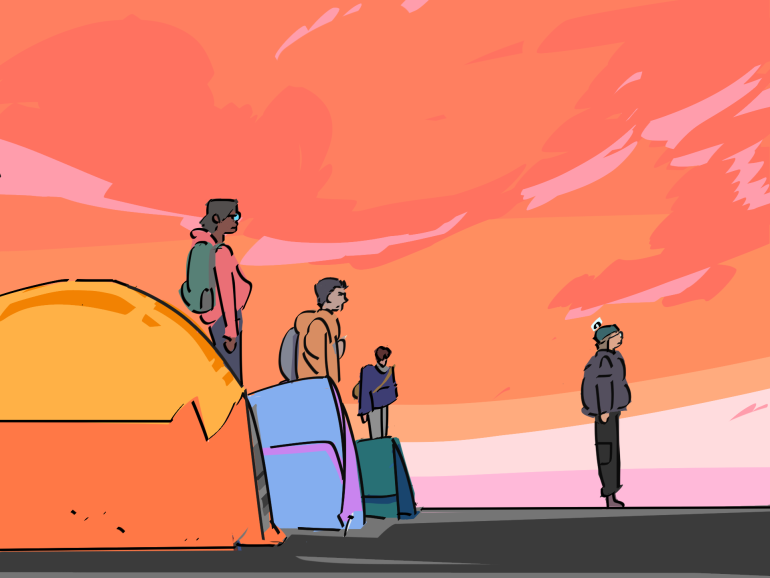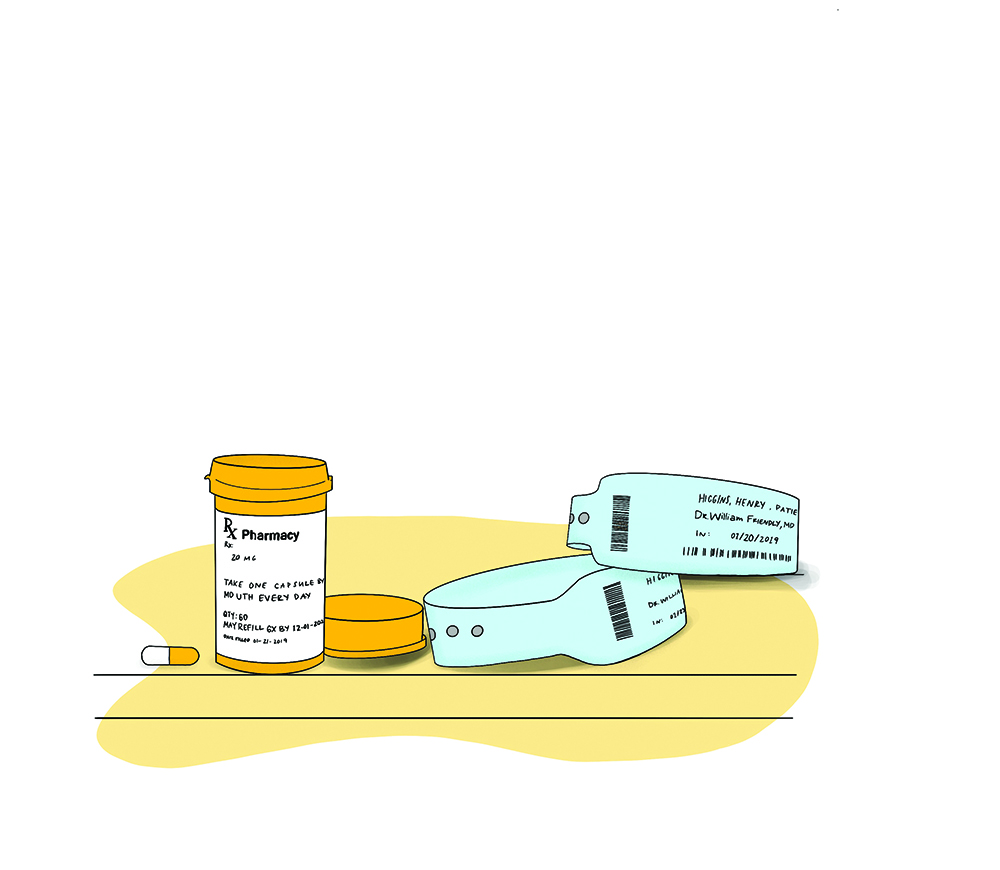In an effort to drive people experiencing houselessness from the city of Portland, Ted Wheeler recently announced a proposed resolution to ban camping within city limits. The plan, however, could be more aptly described as a plan to make a plan—something the mayor has done repeatedly since first running for the office in 2016 when he promised “a new approach” to the houseless crisis. What makes him ineffectual is that rather than doing any “capital-w” Work to approach the crisis in a way that addresses root causes to produce better outcomes for people in poverty, the mayor and his hive mind repeatedly take shortcuts that benefit the wealthy business class. Wheeler fails because he wants to start at the finish line.
Resolution 929, titled “Connect mental health and substance abuse recovery services to unhoused individuals,” states that the City of Portland hopes to partner with Multnomah County to create three sanctioned camping sites, or “campuses” that serve between 150 and 500 people per site. It also proposes a ban on what it calls “self-sited unsanctioned encampments,” which appears to mean anywhere the city chooses to enforce the ban. At the time of this writing, there was no funding for the plan.
On November 3, 2022, the day of the final city council vote on the resolution, Street Roots and the ACLU sent a letter calling to delay the vote—dismissing the plan as taxpayer-funded “political theater.” That letter was ignored and the resolution passed 4-1 with JoAnn Hardesty as the lone “no” vote. The initial announcement of the resolution came roughly three weeks prior to a midterm election in which houselessness was seen by 94% of Portland voters as “a very big problem.”
Ostensibly, Portland’s business community envisions their ends as a thriving city, devoid of encampments, flush with tourists and the money they will inevitably shell out when they visit. When ground broke on the thirty-five-story Ritz-Carlton Hotel in 2019, it gave a concrete sense of where priorities lay for investors who hope to siphon what they can from wealthy and middle-class travelers alike. Through a contract with the city, Ritz developer Walter Bowen is obligated to put $8.1 million toward affordable housing units—a payment that he has delayed making despite the fact that Portland needs to build more affordable housing to address the crisis.
In July of 2017, just seven months after Wheeler took office, the Portland Bureau of Transportation (PBOT) installed forty-five signs near various parks throughout the city that read “No Camping,” and similar signs prohibiting parking near parks at night. The “No Camping” signs included a short list of city ordinances intended to ban camping in these areas. In November of the same year, at the behest of Columbia Sportswear CEO Tim Boyle, Wheeler’s office directed PBOT to post signs downtown warning of Portland’s Public Sidewalk Management Plan, which had gone into effect that August in an effort to ban anyone other than a pedestrian from using the sidewalk. At that time, Portland Police began regular patrols in areas where people were likely to camp, most notably in areas that affected members of the Portland Business Alliance—which includes Columbia Sportswear. Despite these measures, people experiencing houselessness did not suddenly become housed, and the crisis continued.
Marisa Zapata is the Director of the Homelessness Research and Action Collaborative (HRAC) at Portland State University, which she describes as “an interdisciplinary research center focused on developing and promoting applied research that answers the questions of how we solve and prevent, and resolve homelessness.”
The research suggests that the most effective way to do just that is to provide housing. The model known as “Housing First” is an approach to quickly and successfully connect people experiencing homelessness to permanent housing without preconditions or barriers.
“The idea is that by offering somebody a safe and secure place to live—that is housing, meaning that there is actually a bathroom and plumbing and so forth—they are given the best chance to feel supported to get some sleep,” Zapata said. “If you see a mental health care provider, one of the top questions is ‘how much are you sleeping?’ because we know how much sleep regulates our bodies on many levels, and particularly in terms of mental health.”
The Housing First model operates on the simple concept that the solution to houselessness is housing. But it doesn’t end there. Proponents of Housing First recognize that no two people experiencing houselessness have the same stories or the same needs as one another, and long term support structures are necessary to keep people permanently housed.
“It really requires thinking about how we want to invest in one another, in order to allow people to be able to live their best lives,” Zapata said.
That includes connecting people with social workers or addiction treatments when necessary. But in many cases, their most effective strategy is to help people reconnect with friends, family or faith groups who can offer loving support. The model removes judgmental barriers like sobriety or drug treatment that typically derail any movement toward solving a crisis for an individual. Research suggests that the solution to houselessness is far less complicated than it may seem—a sort of paradox that allows society to justify the conditions we see by viewing them as too complicated to solve.
“If it’s such a simple solution—which is providing housing—why haven’t we done it yet?” Zapata said. “That’s a very uncomfortable place for people to sit.”
In September of 2018, in response to a 2009 lawsuit brought by six houseless people in Boise, Idaho, the 9th Circuit Court of Appeals ruled that a city cannot prosecute people sleeping on the street if they have nowhere else to go. That decision effectively removed any ability to enforce the Portland city code that intended to prohibit camping in public rights of way. But in the first year of his second mayoral term, Wheeler again proposed banning camping and sending people to “high-population outdoor camping zones”—an idea that was quickly rebuffed by Dan Ryan, the City Commissioner in charge of Portland’s Housing Bureau.
Then, in 2020, the Center for Disease Control issued guidance on sweeping encampments in light of the COVID-19 pandemic.
“One of the important things that have happened is that the CDC recommended that we not move people during the early stages of a pandemic,” Zapata said. “The general idea was that moving people could be detrimental to everyone’s health, and it was better to leave people in place.” For the most part, Portland did in fact follow that guidance and pause sweeps, during the heightened period of COVID-19 measures.
When COVID-19 first made its way to the United States in 2020, it was all-hands-on-deck for helping the American people to stay afloat. President Trump signed the CARES Act in December of 2020—a $900 billion stimulus package that addressed the financial ruin that many Americans were facing due to job loss. Then in March of 2021, in his first big success as President, Joe Biden signed the American Rescue Plan—a $1.9T stimulus package from Congress that included $22 billion in rental assistance, $5 billion in houselessness aid and nearly $10 billion to help homeowners pay mortgages.
Between the Trump plan and the Biden plan, this aid was a lifeline for many people, but as time wore on and attention to the struggles people were experiencing decreased, that attention was turned to bringing the economy back at the expense of anyone who couldn’t hang on. In May 2022, Biden even went so far as to urge cities to send unspent COVID relief funds to police and public safety.
“I think we definitely have seen an intensity and the discussion coming out of businesses that are downtown around homelessness,” Zapata said. She added that there is a conflation between the impacts of COVID and the perception of houselessness and crime in downtown. While the center of the city does appear less populated generally than it may have a few years ago, it is important to keep in mind that fewer people are commuting into the office than did prior to the pandemic. But in 2022, the media has no incentive to focus on the spectacle of remote workers not going into downtown offices.
“Maybe it’s not that it goes back to what it was before,” Zapata said. “There are different futures to imagine in a central city. Nothing gets resolved by banning people from sleeping outside, and then forcing them into a camp or arresting them. In fact, everything gets made worse in terms of ending or resolving homelessness.”
The City of Portland geared up again in February of 2022 with the announcement of an emergency ban on camping along roadways—the same month that disgraced former mayor and Wheeler-appointed “Director of Strategic Innovations” Sam Adams floated an idea to create shelters to house 3,000 people, guarded by unarmed National Guard members and graduate students from PSU’s School of Social Work. In a scathing statement, the dean of the program Jose Coll pushed back on the idea, stating that “this proposal contravenes social work values and is not being considered by the SSW. The school was not consulted about this plan, and we with PSU government relations are handling this matter.” That May, the city swept twenty-one encampments in Old Town in just a few days, and a total of 206 encampments that month. Yet another announcement came from Mayor Wheeler in June, saying he intended to implement that same strategy citywide.
“We know that sweeps are harmful to people physically, they lose their belongings, and this erodes trust between people who are living outside and people who serve them or work with them,” Zapata said.
She noted that while pods are not housing—because they do not have indoor plumbing or a kitchen—the power of the village pod concept is that it was possible to deploy them rapidly. But the latest resolution from Wheeler kicks the can down the road, with an explicit goal of opening the first of four proposed campuses eighteen months after the city secures funding for the project. In the November 3 vote, Commissioner JoAnn Hardesty proposed moving that goal to six months. But despite their public calls to address houselessness as an emergency, no other commissioner seconded her amendment.
“If they’re going to take three years to get put in, we could have built housing on any of that property,” she said. “We could have at least put the staff time into getting housing to happen instead of staff time into making the villages happen.”
The latest resolution from Mayor Wheeler shows that his office understands many of the issues that people living outdoors face. The official city council document cites the need to address access to services, sanitation, safety, and long waitlists for services—all things that many people who experience houselessness would recommend, according to Street Roots. But the resolution goes on to inadvertently state the ineffectiveness of its own ban and sweep strategy, stating that “unsanctioned encampment removals increased by 2844% from September 2020 to September 2022, and despite the substantial increase in removals, the number of encampments has risen to over 700.”
If removing unsanctioned encampments does not reduce the number of encampments, then why does Wheeler continue to implement more of the same strategy he has attempted for six years? It is a strategy that will continue to fail, and the only solution is to start at the beginning, and do the proven work of housing people first, without judgment or requirements that create barriers and force people to live in the streets.





